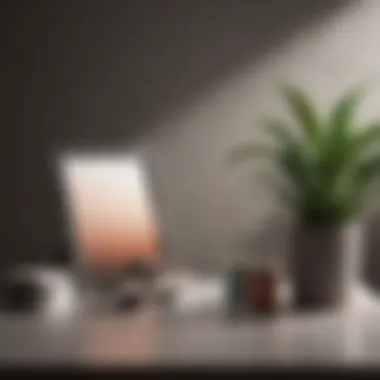Cost Analysis of Painting a Small Room: Budgeting Tips


Intro
Painting a small room can seemingly be a straightforward task. However, taking a closer look reveals a complex web of factors that influence overall costs. For homeowners and renters considering an update to their interior design, understanding these cost factors is crucial. It involves not just the paint itself but also labor, preparation, and potential unforeseen expenses. This guide aims to illuminate the nuances involved, helping you to make informed decisions.
Design Inspirations
When contemplating a new coat of paint, design inspirations can often spark creativity. Understanding current trends can influence both the aesthetic and the budget of a painting project.
Trending Styles
Several design trends have made a mark in contemporary interior design. Minimalist styles continue to gain traction. These focus on the essence of a space rather than excessive decoration. Incorporating textured neutrals can create a serene environment, making a small room feel larger.
On the opposite end, maximalism celebrates vivid colors and patterns. This approach can greatly affect the selection of paints, leading to diverse budget considerations. Reflect on your personal style and how it aligns with these trends.
Color Palettes
Choosing the right color palette can significantly influence both mood and perception of space. Soft pastels tend to create a calm atmosphere, while bold colors demand attention. For example, a light blue or soft green can impart tranquility, making small spaces feel airy.
Conversely, a deep navy or bold red adds richness. When selecting colors, factor in both the desired emotional result and how frequently the colors are changed or updated.
Cost Breakdown
Understanding the costs involved in painting a small room requires a clear breakdown of various components.
Paint Selection
The type of paint chosen is pivotal in determining expenses. Generally, there are three main categories: latex, acrylic, and oil-based paints. Each has its advantages and pricing structures. For instance, latex paints are usually less expensive and easier to clean. Meanwhile, oil-based paints, while more durable, tend to come at a higher cost.
Additionally, selecting a premium brand like Benjamin Moore or Sherwin-Williams could increase the budget further, but clients might appreciate longer-lasting results and better coverage.
Labor Costs
Labor is another major component of the overall expense. The decision to hire professionals or take the DIY route will impact the budget significantly. Professional painters typically charge between $20 to $50 per hour, depending on experience and geographical location. In contrast, choosing to paint yourself can save labor costs, but be prepared for the time investment and potential pitfalls.
"Investing a little extra in professional labor can often save more in material costs through efficient use of supplies."
Maintenance and Upkeep
After completing the painting, maintaining that fresh look is vital. Paint durability can vary. Therefore, understanding how to care for painted surfaces can prolong the fresh appearance and prevent additional expenses over time.
Seasonal Maintenance Checklist
- Inspect walls for wear or damage.
- Clean surfaces periodically with mild soapy water.
- Touch up paint as needed to avoid larger repaint jobs.
Cleaning and Organization Tips
- Use a microfiber cloth to help avoid scratches when cleaning.
- Organize painting supplies to avoid repurchasing materials later.
Small spaces can offer big opportunities for aesthetic improvement through paint. By understanding the cost factors and maintaining a clear strategy, you can create an environment that reflects your taste without exceeding your budget.
Understanding the Basics of Room Painting
Understanding the basics of room painting is a fundamental step for anyone considering refreshing their small space. This section aims to provide a solid overview which is crucial not only for effective execution but also for managing costs effectively. Knowledge of painting basics allows homeowners to make informed decisions about both materials and labor. Knowing the implications of wrong choices can lead to significant cost overruns or unsatisfactory results.
When planning a painting project, it is essential to grasp some core concepts. This includes understanding the characteristics of the room, the types of paint available, and the importance of preparing surfaces correctly. Each aspect contributes to a successful outcome. By gaining a grasp of these preliminaries, it is easier to navigate through the rest of the painting process and avoid unnecessary expenditures that arise from poor planning or ignorance.
Defining a Small Room


A small room can generally be characterized by its limited floor space, which impacts the overall cost of painting. Though definitions may vary, a common benchmark considers rooms under 120 square feet as small. This includes areas like a small bedroom, a personal study, or even a cozy reading nook.
In the context of cost analysis, the size dictates the amount of paint required and the time needed for completion. Since smaller spaces usually require fewer resources, they can often be painted at a lower cost compared to larger rooms. However, one should also consider that smaller dimensions might increase the complexity of painting, particularly with regards to trim work and intricate areas.
Why Paint Matters
The choice of paint plays a colossal role in both the aesthetics and overall ambiance of a room. Paint serves not only as a protective layer but also enhances the beauty of a space. Selecting the right paint color can create various moods; for example, light colors may enhance brightness, while darker hues can provide a sense of coziness.
Moreover, paint quality impacts long-term maintenance costs and durability. Cheaper paints might save money upfront but could require more frequent touch-ups or even a complete reapplication. On the other hand, higher-quality paint may have a steeper initial price but can offer better coverage, lasting performance, and could be more resilient to stains or damage.
Investing in the correct type of paint can yield considerable cost savings in the long-term.
Furthermore, understanding finishes is imperative. Different finishes offer distinct levels of sheen, which can affect reflection of light and ease of cleaning. High-gloss finishes, for instance, are easier to wipe down compared to flat finishes, which may absorb more dirt and grime. Making careful selections here is essential for achieving the desired look while considering maintenance.
Ultimately, the significance of paint lies in its multifunctionality. Understanding why and how paint matters is pivotal for anyone looking to undertake a painting project. This knowledge forms the bedrock for informed decision-making in cost analysis.
Factors Influencing the Cost of Painting
Understanding the factors that influence the cost of painting is fundamental for anyone planning to undertake a painting project, be it a small room in a house or an apartment. Several variables directly affect the overall expenses, and being aware of these can help individuals make informed decisions. Among these factors are the size of the room, the choice of paint, preparation work required, and labor costs. Each of these elements can significantly alter the financial implications of the project.
Size of the Room
The size of the room is one of the most straightforward determinants of painting costs. Larger rooms typically require more paint, which directly increases material costs. The labor involved also increases proportionately, as a bigger area means more time spent applying paint. In contrast, smaller rooms can be economical options for those on a budget. Therefore, accurately measuring the dimensions of the room can assist in precise calculations when estimating total costs.
Choice of Paint
Choosing the right paint is crucial in any painting project and can affect the budget in various ways.
Type
The type of paint significantly influences the overall cost. For instance, latex paint is often preferred for interior projects due to its water-based formula, easy cleanup, and low odor. Choosing low-quality paint may save money initially but can lead to higher maintenance costs down the line due to poor coverage or durability.
Brand
Brand selection also plays a role in the cost of paint. Established brands like Sherwin-Williams and Behr often carry a higher price tag but usually provide better coverage and longevity. Investing in a reputable brand can save money in the long term as it often means less frequent repaints and better results.
Finish
The finish of the paint can impact both aesthetic values and practicality. Options include matte, satin, semi-gloss, and gloss finishes. Matte finishes are usually less expensive but less durable, while glossy finishes tend to be costlier and offer easy cleaning options but might highlight imperfections in the wall surface.
Preparation Work Required
Preparation work is another vital component to consider that can vary widely based on the current state of the room being painted.
Surface Cleaning
Surface cleaning is a critical step before painting. This process involves removing dirt, grease, or any other contaminants that could interfere with paint adhesion. Neglecting this step can result in peeling or uneven finishes later. Though it may seem insignificant, proper cleaning can minimize future repair costs associated with paint failure.
Repairing Imperfections
Repairing imperfections, such as cracks or holes in the wall, is crucial for achieving a smooth finish. While it may incur additional costs upfront, neglecting repairs can lead to further damage and the need for costly remedial action later on.
Priming Surfaces
Priming surfaces, especially when transitioning between different paint types or colors, is a recommended practice. Primer aids in maximizing paint adhesion and color uniformity. Some types of primer are relatively cheap but can save money on high-quality paint by requiring fewer coats.
Labor Costs


Labor costs reflect either the financial outlay of hiring professionals or the investment of personal time and effort into a DIY project.
DIY Painting
Choosing to paint the room oneself can significantly reduce expenses. It allows full creative control and a potential sense of fulfillment. However, it requires time, effort, and basic DIY skills. Risks include possible accidents or lack of professional finish, which could lead to higher costs if a professional needs to redo the work.
Professional Services
Hiring professional painters is an alternative that ensures a consistent and high-quality output. Although this route incurs higher initial costs, it saves time and stress, providing peace of mind that the job is done right. Professionals also often bring valuable experience to the table, potentially saving money through efficiency.
Budgeting for Your Painting Project
Budgeting is a crucial step when planning a painting project for a small room. It helps ensure that all financial aspects are taken into account, preventing overspending and allowing for a smoother process. By understanding costs ahead of time, homeowners can prioritize essentials and adjust their plans according to their financial capability. A well-planned budget can lead to smart decisions and better outcomes in terms of quality.
Creating a Budget Plan
A budget plan serves as a roadmap for your painting project. Begin by determining the overall amount you are willing to spend. This number should reflect all related expenses. Here are some steps to follow:
- Research Costs: Investigate prices for materials and labor in your area.
- Break Down Expenses: Dividing costs into categories can help you see where your money will go. Key categories include paint, tools, and labor.
- Set a Contingency Fund: Adding an extra 10-15% to your budget can help manage any unforeseen costs that arise during the project.
This structured approach enables you to see the total financial picture clearly, creating space for adjustments as needed.
Estimating Material Costs
Material costs can vary widely based on the type of paint and supplies selected. Paint, brushes, rollers, and other tools each add to the total cost. To accurately estimate, consider the following:
- Paint Type: Different paints have varying prices. Latex interior paint is often more affordable compared to high-end finishes.
- Quantity of Paint: Calculate the area to be painted. Typically, one gallon of paint covers about 350 square feet.
- Additional Supplies: Don’t forget to include costs for primer, painter’s tape, drop cloths, and any special tools required.
A detailed list can help streamline purchases and maintain budget discipline.
Accounting for Unexpected Expenses
Unexpected expenses can easily throw a wrench in your plans. Here are key considerations to manage this risk:
- Preparation for Surprises: Always have extra funds allocated for repairs or additional supplies not initially planned.
- Common Issues: Look for signs of damage or mold before starting. Surface repair can often be essential but overlooked initially.
- Realistic Expectations: Understand that projects may take longer than anticipated. Additional labor costs for an extended timeline should be factored in.
By preparing for these possibilities, you can help ensure that your painting project stays within budget and is completed smoothly.
"Effective budgeting for your painting project empowers homeowners to make informed decisions that lead to successful results."
In summary, budgeting for your painting project involves careful planning. Creating a budget plan, estimating material costs, and accounting for unexpected expenses set the foundation for a successful painting endeavor.
Comparing DIY and Professional Painting Services
In the journey of painting a small room, one of the biggest decisions is whether to choose DIY or hire professional services. Each option comes with its unique set of pros and cons, which can significantly impact the total cost and overall satisfaction with the project. Therefore, understanding these differences is crucial for homeowners and renters aiming for effective results and budget management.
Advantages of DIY Painting
Cost Savings
Cost savings represent one of the most appealing aspects of considering DIY painting. When homeowners opt to paint on their own, they eliminate labor costs that might add up quickly when hiring professionals. Painting supplies such as brushes, rollers, and tape are typically affordable. The key characteristic of this aspect lies in the ability to avoid fees that professionals may charge for their expertise and time. While initial expenses may seem low, it’s essential to consider the time investment and potential for mistakes that could lead to repairing costs later. Individuals may find the budget-friendly nature of DIY particularly attractive, as it provides a sense of autonomy over their spending.
Creative Control
Creative control is another significant advantage of choosing to paint a room by oneself. This aspect allows homeowners to make all decisions regarding colors and techniques without input from others. Personal input can lead to a sense of ownership over the final look. The primary feature of creative control is the flexibility it offers when planning and executing the painting project. However, this freedom can also lead to overwhelming choices, especially for less experienced individuals. It may result in a longer decision-making period, which can delay the project completion.
Benefits of Hiring Professionals


Experience and Efficiency
When hiring professional painters, one benefits from their experience and efficiency. Professionals, equipped with skills acquired through training and practice, tend to finish jobs faster than the average DIYer. Their familiarity with various surfaces and materials allows them to navigate potential pitfalls effectively. Efficiency is a crucial element since homeowners might face interruptions in their daily lives while painting. Although this service may come with a higher cost, the time savings and expertise provided can ultimately justify the price.
Quality of Work
The quality of work delivered by professionals often surpasses that of novice painters. Professional painters understand the nuances of achieving an even finish, selecting the right tools for the job, and applying paint correctly. This knowledge can prevent issues such as peeling, cracking, and uneven application that may arise from inexperience. The result is a polished look that significantly enhances the room's aesthetic appeal. Homeowners should weigh the initial investment against potential costs of correcting poor quality work if they choose to DIY, making professional services a worthy consideration.
Assessing the Total Cost of Painting a Small Room
Assessing the total cost of painting a small room is crucial for homeowners or renters planning a painting project. Understanding the financial implications allows for effective budgeting and informed decisions regarding paint selection and labor options. Many factors can influence the total cost, including materials, labor, and additional expenses that are often overlooked.
A thorough examination of these cost components enables individuals to allocate funds properly while also anticipating potential adjustments in budget. A clear perspective on costs helps in weighing options between DIY or hiring professionals, ultimately guiding one to a more satisfactory outcome.
Cost Breakdown
Material Costs
Material costs in painting typically encompass all supplies needed to complete the job. This includes paint, brushes, rollers, tape, and drop cloths. The main characteristic of material costs is their variability – it can differ significantly based on paint type and brand. For instance, premium brands like Sherwin-Williams or Benjamin Moore may carry a higher price tag compared to generic brands, but often offer better coverage and durability.
Investing in quality materials can be beneficial, as they might lead to fewer coats required and a longer-lasting finish. However, the initial financial commitment can be daunting for budget-conscious individuals. The downside of opting for lower-quality materials often surfaces in the form of reduced longevity, necessitating more frequent repainting. Therefore, careful consideration is needed to balance cost against quality when selecting materials.
Labor Costs
Labor costs represent another significant aspect of the overall expense in painting a room. If opting for professional services, understanding the hourly rate or project-based fees becomes essential. Skilled painters may charge more, but their experience typically translates to more efficient work and higher-quality results.
Choosing to go the DIY route may seem like a cost-effective solution, yet it comes with its own set of challenges. While avoiding professional fees can seem appealing, the time and effort required to achieve satisfactory results should not be underestimated. Moreover, mistakes can lead to additional costs if corrections are needed later. Weighing the expertise of professional painters against the desire to save money is vital in making a decision regarding labor costs.
Additional Expenses
Additional expenses often arise unexpectedly during a painting project. These could include special equipment rentals, such as scaffolding, or items like sandpaper or caulk for surface preparation. Other considerations might involve purchasing protective gear or cleaning supplies.
The key characteristic of additional expenses lies in their unpredictability. While some may have a set budget for materials and labor, it is wise to account for these extras that can increase costs. Keeping a contingency fund, generally around 10-20% of the total budget, can be beneficial to handle any surprises without derailing the overall plan.
Understanding the comprehensive cost is essential for a successful painting project, as it leads to better preparation and satisfaction with the results.
Sample Cost Estimates
When planning a painting project, having sample cost estimates can assist in determining the required budget. Paint prices, labor fees, and expected additional costs will vary based on location and specific project requirements, making it important to gather quotes from multiple sources. Obtaining estimates will provide clarity and helps avoid any financial strain during the process.
Overall, a reliable assessment of costs related to painting a small room ensures a smoother experience and ultimately leads to better satisfaction with the project results.
Planning for Future Paint Jobs
Planning for future paint jobs is essential in maintaining the aesthetic appeal and structural integrity of your small room. As with any interior design endeavor, foresight can save both time and money. By understanding the long-term implications of paint choices and maintenance, homeowners can make informed decisions that enhance the value of their living spaces.
Choosing Timeless Colors
Choosing timeless colors is a critical aspect of planning for future paint jobs. Timeless colors, typically neutral shades or classic tones, have enduring appeal. They create versatile environments, allowing for easy updates with accessories or furniture changes. Selecting shades such as soft whites, beiges, or grays, can also make a small room feel more spacious and inviting.
Consider factors such as lighting, room function, and style preferences when selecting paint colors. For instance, natural light can dramatically alter how a color appears throughout the day. Additionally, think about the emotions that different colors evoke. Cool colors like blues and greens promote tranquility, while warm colors such as reds and yellows add energy.
It is advisable to test paint samples on your walls. Observe them at different times of the day, under various lighting conditions. This practice can prevent costly regrets of choosing unsuitable colors. Using tools like color palettes or mobile apps can also assist in visualizing how different combinations work together.
Maintaining Painted Surfaces
Maintaining painted surfaces is crucial for prolonging the life of your paint job. Regular care can keep walls looking fresh and new, ensuring your investment remains worthwhile. Dust and dirt can accumulate over time, dulling the color and affecting the overall appearance of the room.
To maintain your painted surfaces, follow these tips:
- Clean Regularly: Dust walls with a microfiber cloth or use a vacuum with a brush attachment to remove dirt and debris. For deeper cleaning, consider a gentle soap solution.
- Repair Imperfections Promptly: Cracks or chips should be repaired immediately. Leaving them can lead to larger issues over time, requiring more extensive repainting.
- Avoid Harsh Cleaners: Choose gentle solutions to avoid damaging the paint’s finish. Harsh chemicals can strip away the color and sheen.
Taking the time to maintain your painted walls can prevent unforseen costs and preserve the quality of the paint job. Proper planning and upkeep ensure that your small room remains a delightful and appealing space for years to come.
"Good planning prevents poor performance" - a motto that rings true in the quest for the perfect painted room.







